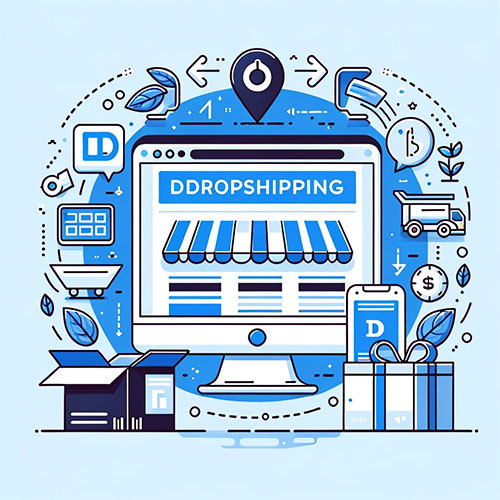Is Dropshipping Legal: Are You Breaking The Law?

Introduction
Dropshipping is a popular e-commerce business model that has gained significant traction in recent years. It offers entrepreneurs an accessible way to enter the retail market without the need for substantial upfront investment in inventory. In this model, a retailer (you) sells products to customers but does not keep goods in stock. Instead, when a sale is made, the product is purchased from a third party (usually a wholesaler or manufacturer) and shipped directly to the customer. As a result, the retailer never sees or handles the product.
Is Dropshipping Legal? A Direct and Concise Answer:
Yes, dropshipping is a legal business practice. However, like any business, it is subject to specific legal and regulatory requirements. These requirements can vary depending on the country or region in which you operate, the nature of the products you sell, and the structure of your business.
Key Points
- Business Model Overview:
- Retailer sells products to customers without holding inventory.
- Orders are fulfilled by a third party who ships directly to the customer.
- Legal Legitimacy:
- Dropshipping is a legally recognized business model.
- Legal compliance varies based on location, product type, and business structure.
- Importance of Compliance:
- Adhering to legal requirements is crucial for the success and sustainability of the business.
- Non-compliance can lead to legal disputes, financial penalties, or business closure.
Quick Info About Dropshipping Legality
| Aspect | Description |
|---|---|
| Legal Status | Legally recognized worldwide |
| Key Compliance Areas | Business registration, tax, consumer protection |
| Varies By | Region, product type, business structure |
| Risks of Non-Compliance | Legal disputes, financial penalties, business loss |

Understanding Dropshipping
Before we get further into the legalities of dropshipping lets just have a brief overview and understand what is dropshipping for anyone starting out.
Dropshipping is a streamlined form of retail business where the seller accepts customer orders but does not keep goods sold in stock.
Instead, in this business model, the seller purchases inventory as needed from a third party – usually a wholesaler or manufacturer – to fulfill orders. The main advantage of dropshipping is that it minimizes the risks and costs associated with maintaining an inventory.
How Dropshipping Works
- Customer Places an Order: A customer places an order on the retailer’s online store.
- Order is Forwarded to the Supplier: The retailer forwards the order details to their supplier.
- Supplier Ships the Product: The supplier prepares and ships the order directly to the customer.
- Retailer Manages Customer Service: The retailer remains responsible for customer service and satisfaction.
Key Components of the Dropshipping Model
- Suppliers: Wholesalers or manufacturers who provide products and handle shipping to customers.
- Retailers: Businesses or individuals who market products to customers and manage sales.
- Customers: End consumers who purchase products through the retailer’s online platform.
Dropshipping Process Flow
| Step | Participant | Action |
|---|---|---|
| Order Placement | Customer | Selects and purchases a product |
| Order Processing | Retailer | Receives and reviews the order |
| Order Fulfillment | Supplier | Packs and ships the product |
| Customer Service | Retailer | Addresses any post-sale inquiries |
Advantages of Dropshipping
- Low Startup Costs: Minimal investment needed to start the business.
- Flexibility: Ability to offer a wide range of products without inventory.
- Scalability: Easy to scale up the business without significant additional costs.
Challenges in Dropshipping
- Dependency on Suppliers: Reliance on third-party suppliers for product quality and timely delivery.
- Competitive Market: High competition due to low entry barriers.
- Lower Profit Margins: Since suppliers handle inventory and shipping, profit margins can be lower than traditional retail models.
Legal Aspects of Dropshipping
While dropshipping is a legal and viable business model, it’s crucial for entrepreneurs to be aware of the various legal aspects that govern it. Understanding and adhering to these legalities ensures the smooth operation of your dropshipping business and helps avoid potential legal issues.
Overview of Legal Considerations
- Business Registration: Mandatory registration of your dropshipping business as a legal entity.
- Consumer Protection Laws: Adherence to laws designed to protect consumers’ rights.
- Tax Compliance: Understanding and fulfilling tax obligations in your operating regions.
- Intellectual Property Laws: Ensuring you do not infringe on others’ trademarks or patents.
- E-Commerce Regulations: Compliance with specific laws governing online businesses.
Importance of Legal Compliance
- Builds Trust: Legal compliance builds trust with customers and suppliers.
- Avoids Penalties: Helps avoid fines and legal disputes.
- Ensures Longevity: Compliance is key to the long-term success of the business.
Key Legal Areas in Dropshipping
| Legal Area | Description |
|---|---|
| Business Registration | Legal entity setup and registration. |
| Consumer Protection | Adherence to laws ensuring customer rights. |
| Taxation | Handling of sales tax, income tax, and other levies. |
| Intellectual Property | Respect for trademarks, copyrights, and patents. |
| E-Commerce Laws | Compliance with online selling and data protection laws. |
Checklist for Legal Compliance
Take notes of this checklist to keep on track with your legal obligations.
- Register your business and obtain necessary licenses.
- Understand and comply with consumer protection laws.
- Set up proper tax handling mechanisms.
- Verify supplier agreements and product legality.
- Ensure website compliance with e-commerce laws.
Business Registration and Legal Structure
Setting up a legal structure for your dropshipping business is a fundamental step. This not only legitimizes your business but also provides a framework for your operations, tax obligations, and liability.
Why Business Registration is Necessary
- Legitimacy: Official registration adds credibility and trustworthiness to your business.
- Legal Protection: A proper legal structure can provide personal liability protection.
- Tax Requirements: Registration is essential for tax purposes and compliance.
Choosing the Right Business Structure
- Sole Proprietorship: Simple, often used by individual entrepreneurs, but lacks personal liability protection.
- Limited Liability Company (LLC): Offers liability protection and tax flexibility.
- Corporation: More complex, suitable for larger businesses, offers liability protection and additional legal requirements.
Comparison of Business Structures
| Structure | Liability | Taxation | Complexity |
|---|---|---|---|
| Sole Proprietorship | Personal | Individual | Low |
| LLC | Limited | Flexible | Moderate |
| Corporation | Limited | Corporate Rates | High |
Steps for Business Registration
- Choose a Business Name: Unique and compliant with local regulations.
- Select a Legal Structure: Based on your business needs and goals.
- Register Your Business: With the appropriate state or local authorities.
- Obtain Necessary Licenses and Permits: Depending on your location and type of products.
Key Considerations
- Determine the scale and scope of your dropshipping business.
- Understand the differences in liability and taxation for each structure.
- Consider future growth and potential need for restructuring.
Compliance with E-Commerce Laws
When operating a dropshipping business, it is crucial to adhere to the specific laws and regulations that govern online commerce. These laws are designed to protect both the consumer and the business and can vary significantly from country to country.
Understanding E-Commerce Laws
- Data Protection and Privacy: Laws like GDPR in the EU or CCPA in California, which regulate how businesses must handle personal data.
- Online Sales Regulations: Rules about how products can be sold online, including pricing, descriptions, and marketing practices.
- Consumer Rights: Laws that protect the rights of consumers, such as the right to return a product within a certain period.
Key Compliance Areas in E-Commerce
- Website Compliance: Ensuring your website meets legal requirements for data protection, accessibility, and consumer rights.
- Product Listings: Accurate and lawful descriptions, pricing, and availability information.
- Marketing Practices: Adhering to regulations regarding advertising, promotions, and email marketing.
E-Commerce Law Compliance Checklist
| Compliance Area | Description |
|---|---|
| Data Protection | Adherence to data privacy laws (e.g., GDPR, CCPA). |
| Sales Regulations | Compliance with laws governing online sales. |
| Consumer Rights | Respect for consumer protection laws and return policies. |
| Digital Marketing | Legal and ethical marketing practices. |
| Accessibility | Ensuring website accessibility for all users. |
Implementing Compliance Measures
- Regularly review and update privacy policies and terms of service.
- Ensure transparent and accurate product descriptions and pricing.
- Comply with email marketing laws like CAN-SPAM Act.
- Implement necessary website features for consumer protection (e.g., return policy, contact information).
- Stay informed about changes in e-commerce laws in your operating regions.
Further Reading for E-commerce Consumer Rights & Laws
United States
- Federal Trade Commission (FTC) – E-Commerce and Online Selling: The FTC provides guidelines and regulations for online businesses in the U.S., focusing on consumer protection. FTC – Business Guidance
- USA.gov – Online Shopping: Offers information on consumer rights, online shopping, and e-commerce regulations in the U.S. USA.gov – Online Shopping
European Union
- Your Europe – Consumer Rights: Provides detailed information on consumer rights within the EU, including e-commerce regulations and cross-border selling. Your Europe – Consumer Rights
- European Consumer Centre Network (ECC-Net): Offers advice on consumer rights in the EU, helping consumers with cross-border disputes. ECC-Net
United Kingdom
- GOV.UK – Consumer Protection: A comprehensive guide on consumer protection laws in the UK, including those relevant to e-commerce. GOV.UK – Consumer Protection
- Citizens Advice – Online Shopping: Provides information and guidance on consumer rights in the UK, specifically for online shopping and e-commerce. Citizens Advice – Online Shopping
Supplier Agreements and Contracts
Effective management of supplier relationships is critical in dropshipping, where your business depends heavily on third-party suppliers for product availability, quality, and shipping. Legal agreements with suppliers are essential to ensure clarity, protect your business, and maintain quality service.
Importance of Legal Agreements with Suppliers
- Risk Mitigation: Contracts help mitigate risks associated with supplier reliability and product quality.
- Clear Expectations: Agreements set clear terms for pricing, delivery timelines, and quality standards.
- Dispute Resolution: Provides a framework for resolving disputes between the retailer and the supplier.
Key Elements to Include in Supplier Contracts
- Product Quality and Specifications: Detailed descriptions of product standards.
- Pricing and Payment Terms: Clear terms on pricing, payment schedules, and penalties for late payments.
- Order Fulfillment and Shipping: Expectations for order processing times and shipping methods.
- Return Policy and Damaged Goods: Procedures for handling returns, refunds, and exchanges.
- Confidentiality and Non-Disclosure: Clauses to protect your business information and trade secrets.
- Termination Clauses: Conditions under which the contract can be terminated.
Checklist for Supplier Agreement
| Element | Description |
|---|---|
| Quality and Specifications | Ensure products meet your quality standards. |
| Pricing and Payment | Defined pricing and payment procedures. |
| Fulfillment and Shipping | Agreed-upon timelines and shipping methods. |
| Returns and Damaged Goods | Procedures for handling returns and damages. |
| Confidentiality | Protection of sensitive business information. |
| Termination | Conditions for ending the agreement. |
Best Practices in Supplier Management
- Conduct thorough due diligence on potential suppliers.
- Negotiate terms that are mutually beneficial and sustainable.
- Maintain open and regular communication with suppliers.
- Monitor supplier performance and review agreements periodically.
- Be prepared to renegotiate or switch suppliers if necessary.
Intellectual Property Rights
In the context of dropshipping, intellectual property (IP) rights play a crucial role. It’s important to ensure that the products you are selling do not infringe upon the IP rights of others, and to understand how to protect your own brand.
Understanding Intellectual Property in Dropshipping
- Trademark Infringement: Avoid selling products that unlawfully use another company’s trademark.
- Patent Issues: Be cautious of products that may infringe on existing patents.
- Copyright Laws: Ensure that any content used on your website, like images or text, is either owned by you or properly licensed.
Avoiding IP Infringement
- Verify Product Legality: Ensure that the products sourced from suppliers do not violate IP rights.
- Conduct Regular IP Audits: Regularly review your product line for potential IP issues.
- Seek Legal Advice: Consult with legal experts in IP law if you have any doubts.
Protecting Your Own IP
- Trademark Your Brand: Secure your brand name, logo, and unique product designs.
- Copyright Your Content: Protect original content created for your website and marketing.
- Patent Your Innovations: If you have developed a unique product or process, consider applying for a patent.
Intellectual Property Checklist for Dropshipping
| IP Aspect | Description |
|---|---|
| Trademarks | Avoid selling trademark-infringing products; trademark your brand. |
| Patents | Ensure products do not infringe on existing patents. |
| Copyrights | Use only licensed or owned content; copyright your original work. |
IP Strategy for Dropshipping Businesses
- Regularly monitor and audit your product catalog for IP compliance.
- Educate yourself and your team about the basics of IP law.
- Develop a response plan for IP infringement accusations.
- Invest in building and protecting your own brand’s IP assets.
Further Reading of Intellectual Property Rights
- World Intellectual Property Organization (WIPO): A global forum for intellectual property services, policy, information, and cooperation. WIPO – Intellectual Property Handbook
- United States Patent and Trademark Office (USPTO): The federal agency for granting U.S. patents and registering trademarks, providing detailed information on both processes. USPTO – General Information on Patents
- European Union Intellectual Property Office (EUIPO): Responsible for managing the EU trademark and the registered Community design, offering resources on IP in Europe. EUIPO – Intellectual Property and Small Businesses
- Intellectual Property Office (IPO) – UK: The official UK government body responsible for IP rights, offering extensive resources and guides. IPO UK – Intellectual Property and Your Work
- World Trade Organization (WTO) – TRIPS (Trade-Related Aspects of Intellectual Property Rights): Information about the WTO’s agreement on IP rights, including international standards and practices. WTO – Intellectual Property (TRIPS)
- Harvard Business Review – Articles on Intellectual Property: A collection of articles and resources providing insights on the strategic value of IP rights in business. HBR – Intellectual Property
Tax Obligations
Navigating the complexities of tax obligations is a critical aspect of running a successful dropshipping business. Understanding and complying with tax laws in your operating regions will help you avoid legal issues and penalties.
Understanding Tax Requirements
- Sales Tax: Know when and how to collect and remit sales tax, which varies by country and region.
- Income Tax: Regular reporting and payment of income tax on profits earned from your business.
- International Tax: Considerations for taxes when selling to customers in different countries.
Steps for Tax Compliance
- Register for Taxes: Obtain necessary tax IDs and registrations in your operating regions.
- Understand Local Tax Laws: Each region may have different tax rates and rules.
- Use Tax Software or Professionals: Utilize tax software or hire a tax professional for accurate tax calculation and filing.
Links for Further Reading on Tax Compliance
- Internal Revenue Service (IRS) – U.S. Tax Information
- Canada Revenue Agency – Business Taxation Guide
- European Union – VAT Rules and Rates
Tax Compliance Checklist
| Tax Type | Description | Action Required |
|---|---|---|
| Sales Tax | Collection and remittance of sales tax. | Register and report as required. |
| Income Tax | Payment of taxes on business profits. | File annual tax returns. |
| International Tax | Taxes on international sales. | Understand and comply with regulations in customer regions. |
Best Practices for Tax Management
- Keep detailed financial records of all transactions.
- Stay updated on tax law changes in your operating regions.
- Consider hiring a tax advisor for complex tax situations.
- Regularly review your tax strategy to ensure ongoing compliance.
Consumer Protection Laws
Adhering to consumer protection laws is vital in dropshipping, as it not only legalizes your operations but also builds trust with your customers. These laws vary globally but generally aim to ensure fairness, transparency, and the rights of consumers.
Understanding Consumer Rights
- Return and Refund Policies: Laws governing the return of goods and refunds.
- Product Quality and Safety: Standards for ensuring the products are safe and as described.
- Fair Advertising: Regulations to prevent misleading or false advertising.
Implementing Consumer Protection Practices
- Clear Return Policy: Develop a transparent and lawful return policy.
- Accurate Product Descriptions: Ensure all product listings are accurate and honest.
- Responsive Customer Service: Establish efficient processes for handling customer inquiries and complaints.
Links for Further Reading on Consumer Protection
- Federal Trade Commission (FTC) – Consumer Protection
- European Consumer Centre Network – EU Consumer Rights
- Australian Competition & Consumer Commission – Consumer Rights
Consumer Protection Law Compliance
| Aspect | Description |
|---|---|
| Return Policy | Clear, compliant policy on product returns and refunds. |
| Product Descriptions | Accurate, honest descriptions of products. |
| Customer Service | Prompt and effective resolution of customer issues. |
Best Practices in Consumer Protection
- Regularly review and update your policies to remain compliant.
- Train your team in consumer rights and effective communication.
- Monitor customer feedback and adjust practices accordingly.
- Keep abreast of changes in consumer protection laws in your regions.
Shipping and Customs Regulations
Navigating shipping and customs regulations is a critical aspect of international dropshipping. Understanding these regulations ensures smooth delivery of products to customers and avoids potential legal and logistical problems.
Understanding Shipping Regulations
- Shipping Restrictions: Awareness of items that cannot be shipped to certain countries.
- Carrier Regulations: Different carriers have their own sets of rules and limitations.
- Insurance and Tracking: Offering insurance and tracking options to customers.
Managing Customs and Import Regulations
- Customs Duties and Taxes: Understanding how customs duties and taxes are calculated and who is responsible for paying them.
- Customs Declarations: Properly declaring the contents and value of shipped goods.
- Compliance with Import Regulations: Ensuring that the products comply with the import regulations of the destination country.
Links for Further Reading on Shipping and Customs
- World Customs Organization – Customs Information
- International Chamber of Commerce – Incoterms Rules
- U.S. Customs and Border Protection – Importing into the United States
Key Shipping and Customs Considerations
| Aspect | Description |
|---|---|
| Shipping Restrictions | Understanding what can and cannot be shipped. |
| Customs Duties | Knowledge of customs duties and who pays them. |
| Compliance | Ensuring products meet the import regulations. |
Best Practices in Shipping and Customs Management
- Partner with reliable shipping carriers familiar with international regulations.
- Clearly communicate shipping policies and costs to customers.
- Keep up-to-date on changes in international trade and customs regulations.
- Consider using a customs broker for complex shipping scenarios.
Risk Management and Compliance
Managing risks and ensuring compliance are fundamental aspects of running a successful dropshipping business. It involves identifying potential risks, understanding the legal and regulatory environment, and implementing strategies to mitigate these risks.
Identifying Common Risks in Dropshipping
- Supplier Reliability: Risks associated with supplier inconsistencies or failures.
- Legal and Regulatory Changes: Keeping up with changes in laws that impact your business.
- Market Fluctuations: Understanding and adapting to market trends and consumer preferences.
Compliance in Dropshipping
- Legal Compliance: Adhering to all applicable laws and regulations in your operating regions.
- Financial Compliance: Ensuring accurate financial reporting and tax filing.
- Operational Compliance: Maintaining standards in business operations, including customer service and shipping.
Strategies for Risk Mitigation
- Diversify Suppliers: Reduce dependency on a single supplier to mitigate supply chain risks.
- Stay Informed: Regularly update your knowledge about the legal and market changes.
- Insurance: Consider business insurance to protect against unforeseen events.
Links for Further Reading on Risk Management
- U.S. Small Business Administration – Managing Risks
- Entrepreneur – Risk Management in Business
- Harvard Business Review – Strategies for Risk Management
Risk Management Checklist
| Risk Type | Strategy |
|---|---|
| Supplier Risks | Diversify supplier base, maintain strong relationships. |
| Regulatory Changes | Stay updated on legal and market changes. |
| Market Trends | Continuously analyze market data and adapt strategies. |
Ensuring Compliance
- Conduct regular legal audits to ensure compliance with current laws.
- Implement strong financial management and reporting systems.
- Develop a proactive approach to customer service and issue resolution.
Conclusion
Dropshipping is a legal, flexible, and potentially profitable business model that allows entrepreneurs to enter the e-commerce space with relatively low upfront costs.
However, as with any legitimate business venture, it requires careful attention to legal and regulatory compliance, supplier relationships, tax obligations, consumer protection laws, and shipping and customs regulations.
Understanding and navigating these aspects are crucial for the long-term success and sustainability of your dropshipping business.
Key Takeaways
- Legal and Ethical Practices: Ensuring legal compliance in all aspects of your business is not just mandatory but also beneficial for building trust and reputation.
- Supplier and Product Management: Careful selection and management of suppliers and product offerings are critical for maintaining quality and customer satisfaction.
- Adaptability and Continuous Learning: Staying informed about the latest trends, market changes, and technological advancements is essential to remain competitive and grow your business.
Final Thoughts
While dropshipping is legal and offers significant opportunities for entrepreneurs, it comes with its own set of challenges and responsibilities.
By focusing on compliance, quality, and customer service, and staying informed about industry changes, you can build a resilient, ethical, and successful dropshipping business.





